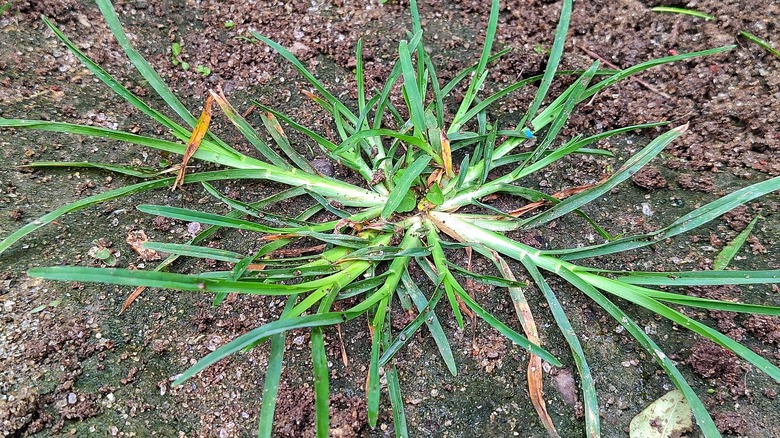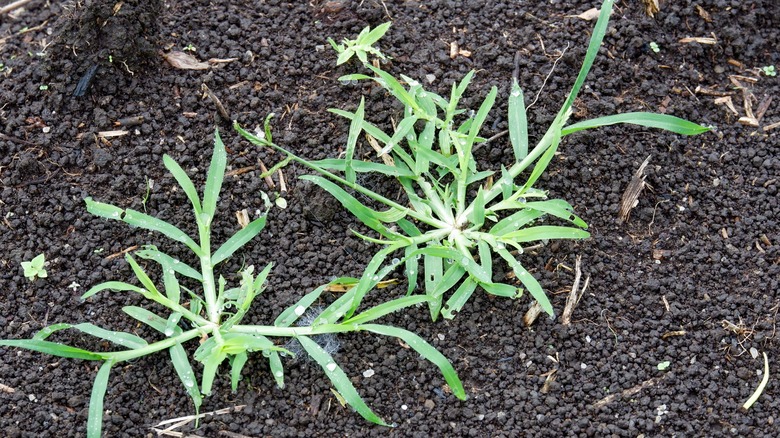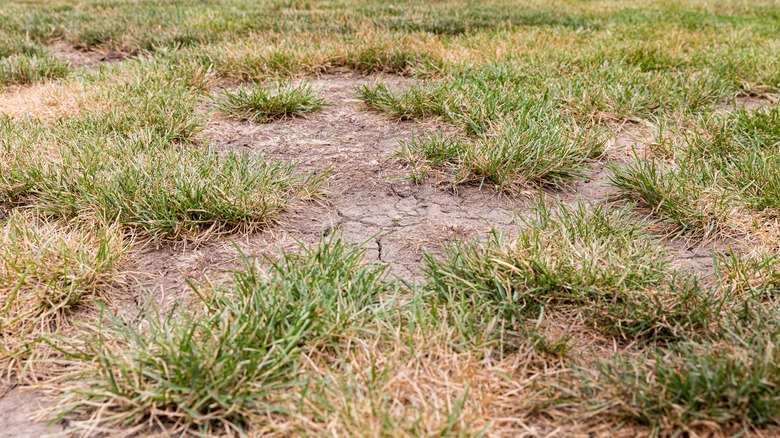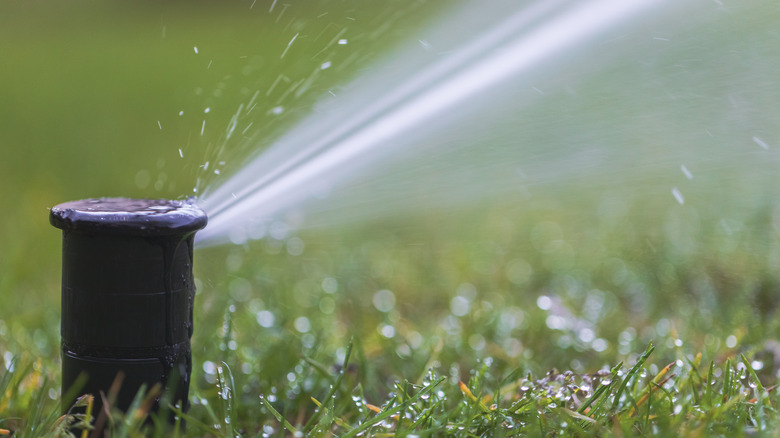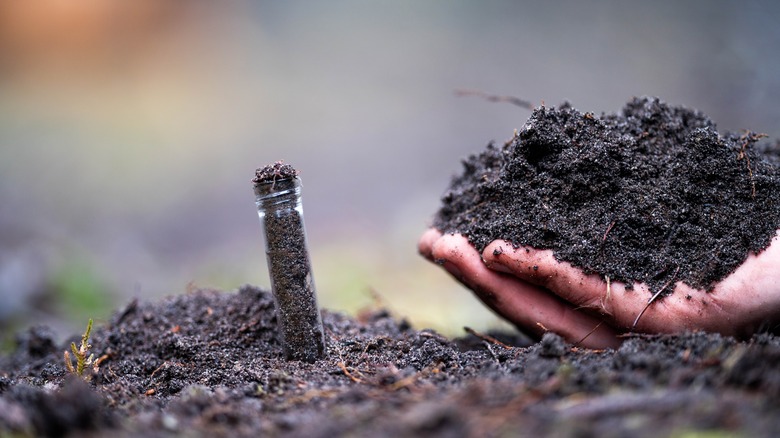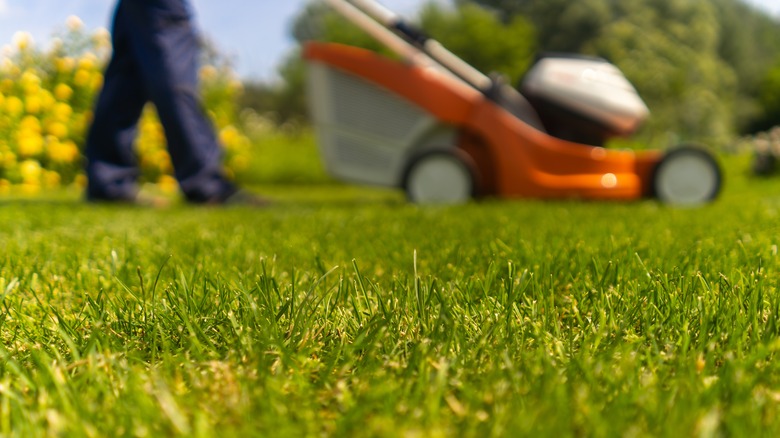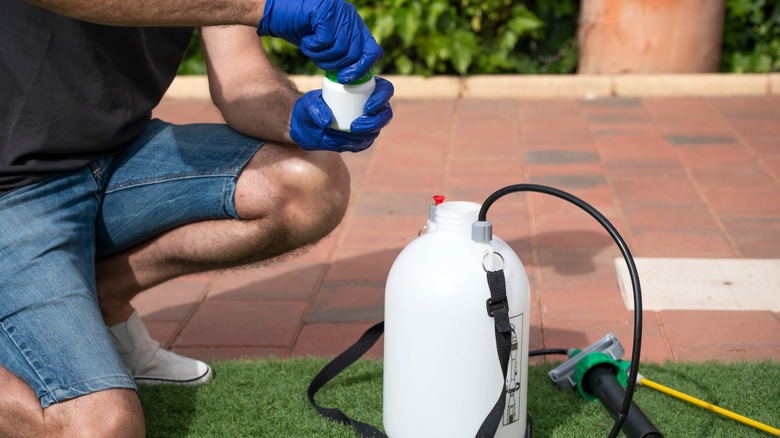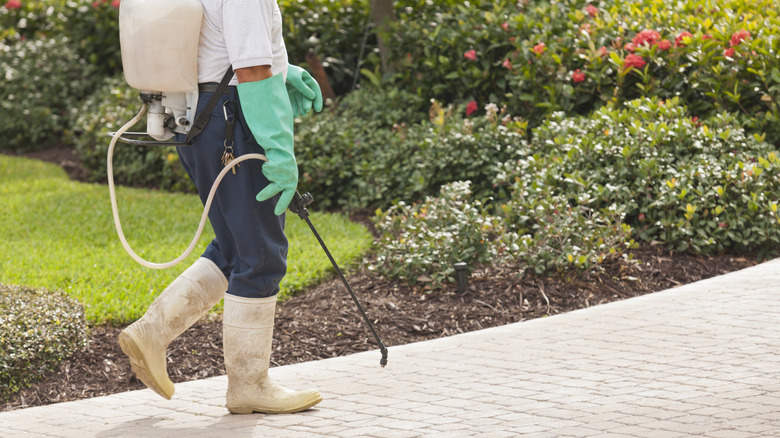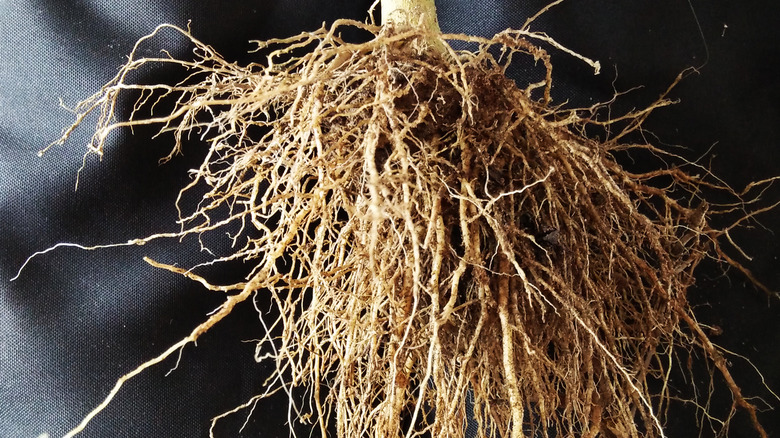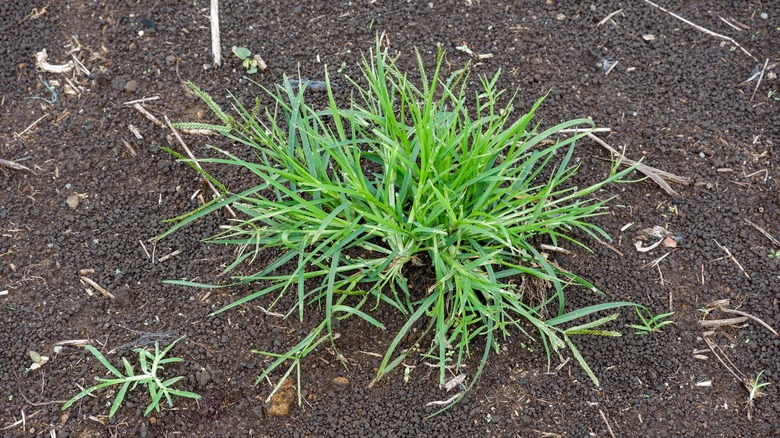Mistakes Everyone Makes When Dealing With Pesky Goosegrass
Every homeowner knows the nightmare that weeds cause in a lawn or garden. Although some weeds can be somewhat manageable, others can cause serious issues. Goosegrass (Eleusine indica) is a stubborn weed known for its wiry stems and flattened, white seed heads. It thrives in compact, nutrient-poor soils and will happily pop up in bare spots of your lawn. Not taking appropriate action to eliminate this rapid-growing plant could lead to it taking over and competing for nutrients with desirable plants in your garden. Because it's trickier to get rid of than many other weeds, your typical weed-removing strategy may not have what it takes to tackle goosegrass.
To fight off goosegrass in your yard, it's important to understand what you're working with. It has a tough underground root system, so you must take additional steps when hand-picking. Even reaching for the herbicide doesn't always get the job done. Goosegrass is resistant to several types of weed killers, so choosing the wrong type or not applying it at the right time likely won't help your situation. Although tricky, getting rid of this pesky weed isn't impossible. By avoiding the most common mistakes below, you have the best chance for a goosegrass-free yard.
Not taking care of it quickly
Goosegrass can become a major problem if you don't get rid of it as soon as you notice it. Each plant is capable of producing as many as 50,000 seeds, which can spread rapidly across your lawn. This fast-growing weed tends to germinate in late spring when the soil temperature warms to about 55 degrees Fahrenheit, and it won't be long before you see bursts of greenery appear. Young plants (which look like a single leafy stalk) tend to be easier to deal with as their root systems are less developed, making it easier to remove the entire structure. If you wait, you could wind up trying to tackle an infestation of plants with deep, established root systems.
It's probably goosegrass if you spot a grassy weed that looks flattened as if it's been trampled on. Once you identify the weed in your yard, it's time to take action. Whether you hand-pick or apply herbicides, you'll want to keep an eye on the area to make sure new plants aren't popping up. Goosegrass spreads its seeds via wind and even by getting stuck on your shoes or pets' feet and tracked across your yard.
Having bare spots in your lawn where goosegrass can take over
Bare spots in your lawn are open invitations for weeds like goosegrass. Because there aren't any other plants for it to compete with, thin or patchy areas in your lawn give this weed a place to establish itself. Once it's claimed its territory, it can spread rapidly, choking out your turf or other plants. Goosegrass can thrive in nearly any soil type, so most unoccupied areas can make an appropriate spot for the seeds to germinate, grow, and become problematic. Thick, healthy grass makes it more challenging for undesirable plants to grow, so do your best to stay on top of your lawn care.
First, choose a high-quality grass seed that works best in your region, and keep up with watering and fertilization to keep it healthy. Additionally, make sure you mow your lawn at the right time of day and at the appropriate height to encourage vigorous growth that helps prevent weeds. If there are bare or unhealthy spots in your yard, consider over-seeding to fill them with new grass. Another option is to replace your grass with a ground cover. Many native ground covers not only choke out weeds but typically don't require as much maintenance to thrive. For example, stonecrops (Sedum) are low-growing flowering plants that can help prevent weeds and rarely need mowing. Once established, it's drought- and heat-resistant, so it doesn't take much from you to keep it happy.
Keeping your soil overly moist
You may have heard that your grass needs a lot of water to grow abundantly, and you may even make the mistake of watering your lawn every day. However, just like any other plant, it's possible to overdo it. Overwatering your lawn can cause a host of problems that create an environment where goosegrass thrives. Because this weed loves a heavy drink of water, overly moist soil is the key ingredient that will help it grow. Additionally, an excessively wet lawn can weaken your existing grass, leaving it more susceptible to weeds. Soggy soil can also cause your lawn to have shallow root systems, making it harder for the grass to combat resilient weeds like goosegrass.
Each type of grass needs a different amount of water to grow its best. For example, bermudagrass likes ½ to 1 inch of water a week, whereas tall fescue will drink up 1 to 2 inches a week. If using a sprinkler system, it'll need to be on a total of about one hour to provide your lawn with 1 inch of water, though this depends on your sprinkler head. You should also factor in natural rainfall to avoid giving your yard double the hydration. Every homeowner slips up from time to time, so if you do accidentally overwater your grass, put the hose down and let the soil dry out. Your lawn should bounce back as long as you switch to a proper watering schedule.
Neglecting soil health
Weeds are an indicator that you've been ignoring your soil's health. Goosegrass thrives in compacted soils, so seeing its green stalks pop up can indicate poor draining. Most desirable grasses need well-draining soils to allow their roots to develop. Compact dirt can make it challenging for your turf to absorb nutrients and oxygen, which is necessary for optimal growth. Unfortunately, this type of environment will cause your grass to be weaker while giving goosegrass the tools it needs to spread vigorously. By fixing drainage issues and staying on top of lawn health, you can keep your turf thriving while discouraging pesky weeds.
Poor drainage can become an issue if there is a lot of clay in the ground, the area has heavy foot traffic, or if you are overwatering. Supplementing the soil with organic matter can help break up the dirt and provide more aeration, allowing water to flow more freely. To help prevent it from becoming compacted, lessen foot traffic if possible and switch up mowing patterns to prevent continuous pressure in one area. Because goosegrass can also indicate poor-quality soil, consider testing it to assess the pH level to identify any nutrient deficiencies.
Attempting to cut goosegrass with a lawnmower
Just like bare spots in your yard can create an opportunity for goosegrass to pop up, so can a lawn cut too short. As a low-growing plant, goosegrass isn't destroyed by mowing and can produce new growth if the entire central crown isn't removed. Additionally, if you cut your lawn too short and too often, you could instead weaken the turf, causing it to struggle to outcompete goosegrass. Although goosegrass can spread through underground rhizomes, it primarily spreads through seeds. So, you could accidentally exacerbate the problem by spreading the seeds across your lawn with the mower.
Each grass species is different, so determine the proper height to mow your lawn and avoid running over the goosegrass as much as possible. Rather than turning to the lawnmower to eradicate this seed-spreading weed, it's more effective to hand-pull or use herbicides. The key to eliminating this weed once and for all is to remove the entire root system, making it impossible for it to sneak back through the soil. Plus, manually extracting weeds or using chemicals reduces the chance of accidentally spreading seeds.
Not applying the right type of herbicide
While you may think chemicals are foolproof when it comes to eliminating weeds, you need the right product to control goosegrass in your lawn. Goosegrass is resilient, so most common lawn herbicides aren't strong enough to eliminate it. It's tough, and the fibrous root system needs to be completely killed off, as it can grow back if roots are not totally removed. Even worse, if you do use an herbicide that has the power to tackle goosegrass, this tough weed can become resistant over time. However, with the right products and a little knowledge, you can destroy this pesky weed with chemicals.
All-purpose weed killers might work on goosegrass, at least partially, if you are lucky. But, when choosing herbicides to control goosegrass, it's best to look for products that are formulated to tackle it. Read product labels closely to make sure goosegrass is listed as one of the weeds it targets. Look for active ingredients that are known to combat grassy weeds, like prodiamine, which can effectively prevent seeds from sprouting. However, you may find that your once holy grail chemical isn't working as well as it did in previous years. To prevent goosegrass from becoming resistant, you'll need to rotate the type of herbicide you use.
Using herbicide at the wrong time
The right timing makes all the difference when using herbicides to control grassy weeds like goosegrass. Even if you have an effective product, using it at the wrong stage of growth will likely yield poor results. For example, if you apply a pre-emergent herbicide too early, the seeds may have already germinated, so the herbicide won't be able to do its job to prevent them from sprouting. On the other hand, post-emergent herbicides work best on goosegrass plants that are actively growing. Using them before the weeds fully mature can reduce their effectiveness.
Although pre-emergent and post-emergent herbicides have their place, it's best to opt for pre-emergent herbicides if timing allows you to. Not only does it prevent the weed from germinating in the first place, but post-emergents can cause damage to turf if not done correctly. It's best to apply pre-emergents in the spring when the ground is about 55 degrees Fahrenheit, as seeds will start to germinate as the soil warms up. If you're unsure, use a thermometer to check the soil temperature. That said, it's always better to err on the side of too early since the chemicals will likely remain dormant in the soil. You can apply your pre-emergent once again in the fall as the ground cools down again. Post-emergents work best when the soil is warm, between 65 and 85 degrees Fahrenheit.
Leaving behind the root system
While handpicking may work to control small goosegrass populations, it's possible to leave bits of the root in the soil, causing it to regrow. All it takes is for a tiny root fragment left behind for the plant to resurface. Because goosegrass has a tough, fibrous root system, tugging it out with your hands often isn't enough to get everything out of the ground. With the help of a gardening tool, you can typically remove smaller plants. Once they mature and grow larger, it's not only more physically demanding, but you'll have a bigger risk of not clearing out the entire structure.
Although there aren't many positives about goosegrass, one good thing is that it can be easier to physically remove than other weeds. However, you can't wait too long; older plants can have roots as deep as 6 feet, making it nearly impossible to extract it all. If goosegrass is younger and small, use a gardening trowel to get under the roots, ensuring you get the entire system. When hand-picking, immediately dispose of unwanted plants in a trash bag to avoid redistributing the seeds. Wash any tools you use and clothing worn during the process for further seed dispersal prevention. Once you've tossed out all the weeds, seed the bare patches in your lawn to help keep goosegrass from coming back.
Attempting to hand-pick older plants
Hand-picking older plants is generally not recommended. Mature goosegrass plants have well-established root systems that anchor the weeds deep into the soil. Even if you only have a few areas with goosegrass popping up, mechanical removal is extremely labor-intensive. Unfortunately, you'll likely put in a lot of hard work, only for it to have been a waste when the plants resurface.
Only manually remove grassy weeds when there are only a few small plants to tackle. If mature plants have taken over your lawn, your best course of action will be sticking to an herbicide strategy. Another mistake some homeowners make is attempting to remove the plants after killing them with an herbicide. Big or small, you should leave them be for at least a few days and let the chemicals soak into the leaves and down to the roots. That said, if the herbicide is effective, you shouldn't need to worry about pulling them at all.
Removing goosegrass in dry soil
If you're only dealing with a couple of small goosegrass plants, you may decide to roll up your sleeves and pull them out one by one. However, removing weeds from dry soil can make the job harder than it needs to be. When the soil lacks moisture, the roots can be more firmly anchored, making it hard to get the entire root system. Additionally, dry dirt also indicates that the roots are also dry, making them more susceptible to breaking off.
Although you don't want to weed when the soil is extremely dry, soggy soil isn't the best time for this process either. Ideally, the ground should be soft enough that the roots glide out more easily but not so wet that you're working with a muddy, clumpy mess. Wait a couple of days after rainfall when the ground is still damp but has had time for some water to evaporate. Weeding your garden in the morning is another effective option. The pretty morning dew will give your soil just enough moisture to make the job a little easier. If all else fails, use the garden hose to soak the soil for a bit before digging out the goosegrass.
